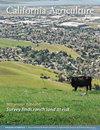根据当地土壤条件的不同,土壤健康实践会产生不同的结果
IF 1.1
4区 农林科学
Q2 AGRICULTURE, MULTIDISCIPLINARY
引用次数: 2
摘要
土壤有机质含量是土壤健康的重要指标。施用堆肥或粪肥、种植覆盖作物、减少耕作和增加作物多样性可能会增加土壤有机质。然而,无论管理实践如何,土壤有机质在不同的环境中都会有巨大的差异。这就需要一个框架来推荐基于地点的土壤健康实践并评估其结果。我们使用了一个新的框架,将土壤调查数据分组到加利福尼亚州中央山谷和中央海岸的七个地区。这些地区要么有性能限制,如根系限制层、盐度和收缩膨胀行为,要么有相对均匀的、粗糙到壤土,非常适合农业。这些固有条件会影响土壤对旨在改善土壤健康的做法的反应。以葡萄园为例,我们发现土壤健康区域之间存在显著的土壤有机质对比,但在特定区域内不同的管理方法之间却没有。我们还在几项长期实验中表明,保护措施可以改善或有助于保持土壤健康,但固有的土壤特性和种植系统类型会影响结果。本文章由计算机程序翻译,如有差异,请以英文原文为准。
Soil health practices have different outcomes depending on local soil conditions
The amount of soil organic matter is a critical indicator of soil health. Applying compost or manure, growing cover crops, reducing tillage, and increasing crop diversity may increase soil organic matter. However, soil organic matter can vary dramatically in different environments, regardless of management practices. This calls for a framework to recommend place-based soil health practices and evaluate their outcomes. We used a new framework that groups soil survey data into seven regions in California's Central Valley and Central Coast. These regions either have performance limitations, such as root restrictive horizons, salinity, and shrink-swell behavior, or have relatively homogeneous, coarse-to-loamy soils ideal for agriculture. These inherent conditions affect a soil's response to practices designed to improve soil health. Looking at vineyards as an example, we find significant soil organic matter contrasts between soil health regions but not among contrasting management approaches within a given region. We also show that conservation practices improve or help maintain soil health in several long-term experiments, but inherent soil properties and types of cropping systems affect outcomes.
求助全文
通过发布文献求助,成功后即可免费获取论文全文。
去求助
来源期刊

California Agriculture
农林科学-农业综合
CiteScore
2.40
自引率
7.70%
发文量
17
审稿时长
>12 weeks
期刊介绍:
Information not localized
 求助内容:
求助内容: 应助结果提醒方式:
应助结果提醒方式:


